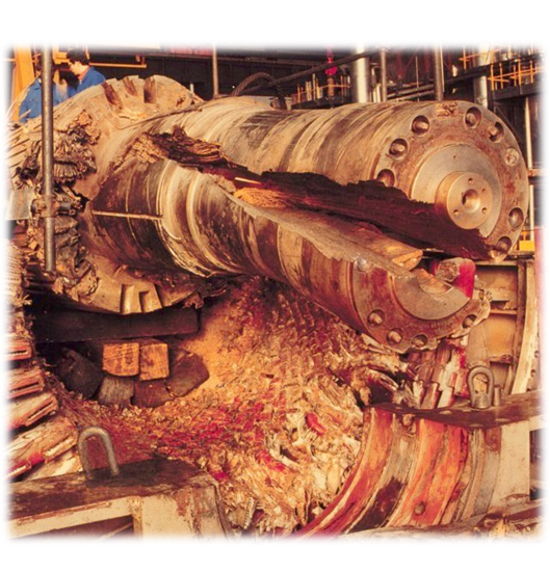

|

|

|

|

|

|

|

|

|

|

|

|

|

|

|

|

|

|

|

|

|

|

|

|

|

|

|

|

|

|
PA UT (PAUT): Solid and Hollow Shafts, Rods, Axles, Thick Wall Tubes, Fitting Lugs, etc
Usually the 100% inspection of the hollow shafts is performed with the use of probe system scanning over the entire rotor length from the bored surface (ID side). For the solid shafts the inspection is performed from the OD surface; the same inspection is suitable for the screening of the hollow shafts in the cross sections in between the rings carrying the turbine blades
Depending on the rotor type the inspection with use of conventional probes lasts 6...7 work shifts. To reduce the inspection time to 1 work shift there was an inspection procedure based on use of the PA modality developed by Sonotron NDT in cooperation with IEC. The inspection is implemented with the use of ISONIC series PA instruments ISONIC 3510, ISONIC 2010, and ISONIC 2009 UPA Scope through running of the RODScan Inspection SW application utilizing the True-to-Geometry (True-to-Shape) S-Scan coverage and imaging strategy. The complete cross sectional view is formed in one revolution of the shaft through superimposing of all S-Scan images obtained within entire revolution. The raw data A-Scans (primary and superimposed according to the settled focal laws) composing every recorded S-Scan image are stored completely and may be played back off-line providing the all-standards-compliant A-Scan based evaluation



Whilst running the instruments in the RODScan inspection mode the S-Scan coverage and capturing of the S-Scans over entire shaft rotation may be performed with the use of EquPAS and FMC/TFM protocols simultaneously: this increases the speed and precision of the defects evaluation significantly being especially important for the monitoring of the discontinuities in the shaft material until developed to the critical shape / dimensions. The increased inspection speed and precision of the evaluation allow prolonging of the service life and save the expenses for the turbines health monitoring
Initially designed for the inspection of the turbine shafts the RODScaninspection SW application was found very useful for the various axles, thick wall tubes, other round and tubular cross-section parts and materials, fittings lugs in the aircraft, and the like
|
This inspection software option is available for the ISONIC 3510, ISONIC 2010, and ISONIC 2009 UPA Scope instruments and featured with:
- True-To-Geometry Rod Cross Section Overlay Volume Corrected Imaging
- Sector-Scan Cross Sectional Coverage
- Intuitive Image Guided PA Pulser Receiver with Beam Forming View
- DAC / TCG Normalization
- Built-In Solid / Hollow Rod Geometry Editor and Ray Tracer - Scanning Pattern Design
- Independent on TCG Angle Gain Compensation / Gain Per Focal Law Correction
- Encoded and Time based Overall Rod Cross Section Coverage Through Superimposing of Sector Scans Obtained Through Rotation of the Rod
- 100% Raw Data Capturing
- FMC/TFM Protocol for the data acquisition and imaging
- Comprehensive Postrpocessing Toolkit Including:
- Recovery and Evaluation of the Captured A-Scans from the Recorded Cross Sectional Views and C-Scans
- Recovery of the Cross Sectional Views from the Recorded C-Scans
- Converting Recorded C-Scans or their Segments into 3D Images
- Off-Line Gain Manipulation
- Off-Line DAC Normalization of the Recorded Images / DAC Evaluation
- Numerous Filtering / Reject Options ( by Geometry / Position / By Amplitude db-to-DAC / etc ) and Regeneration of the Corresponding of Editable Defects List and Storing it into a Separate File
- Defects Sizing
- Automatic creating of inspection reports - hard copy / PDF File
The video below illustrates in-maintenance evaluation of the discontinuity in the 18"OD / 6"ID hollow shaft including the stage of instrument calibration, scanning above the OD surface, and postprocessing
The video below illustrates in-service monitoring of the same discontinuity
Full cross-sectional coverage and recording is achieved through circumferential scanning above OD surface either encoded or time based. The video below shows the result of such encoded scanning and postprocessing including precise sizing of the imperfection
Note: In order to accelerate the data stream the video above is linked to the Youtube. In case the YouTube may not be accessed from your location please use the links below

|

|

|
DOWNLOAD AND PLAYBACK THE EXEMPLARY INSTRUMENTS FILES
|

